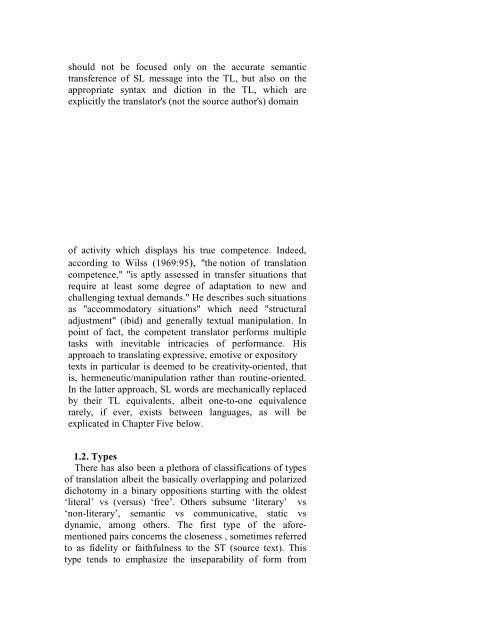424_2061_A.B.
424_2061_A.B.
424_2061_A.B.
- No tags were found...
Create successful ePaper yourself
Turn your PDF publications into a flip-book with our unique Google optimized e-Paper software.
should not be focused only on the accurate semantictransference of SL message into the TL, but also on theappropriate syntax and diction in the TL, which areexplicitly the translator's (not the source author's) domainof activity which displays his true competence. Indeed,according to Wilss (1969:95), "the notion of translationcompetence," "is aptly assessed in transfer situations thatrequire at least some degree of adaptation to new andchallenging textual demands." He describes such situationsas "accommodatory situations" which need "structuraladjustment" (ibid) and generally textual manipulation. Inpoint of fact, the competent translator performs multipletasks with inevitable intricacies of performance. Hisapproach to translating expressive, emotive or expositorytexts in particular is deemed to be creativity-oriented, thatis, hermeneutic/manipulation rather than routine-oriented.In the latter approach, SL words are mechanically replacedby their TL equivalents, albeit one-to-one equivalencerarely, if ever, exists between languages, as will beexplicated in Chapter Five below.1.2. TypesThere has also been a plethora of classifications of typesof translation albeit the basically overlapping and polarizeddichotomy in a binary oppositions starting with the oldest‘literal’ vs (versus) ‘free’. Others subsume ‘literary’ vs‘non-literary’, semantic vs communicative, static vsdynamic, among others. The first type of the aforementionedpairs concerns the closeness , sometimes referredto as fidelity or faithfulness to the ST (source text). Thistype tends to emphasize the inseparability of form from12
















